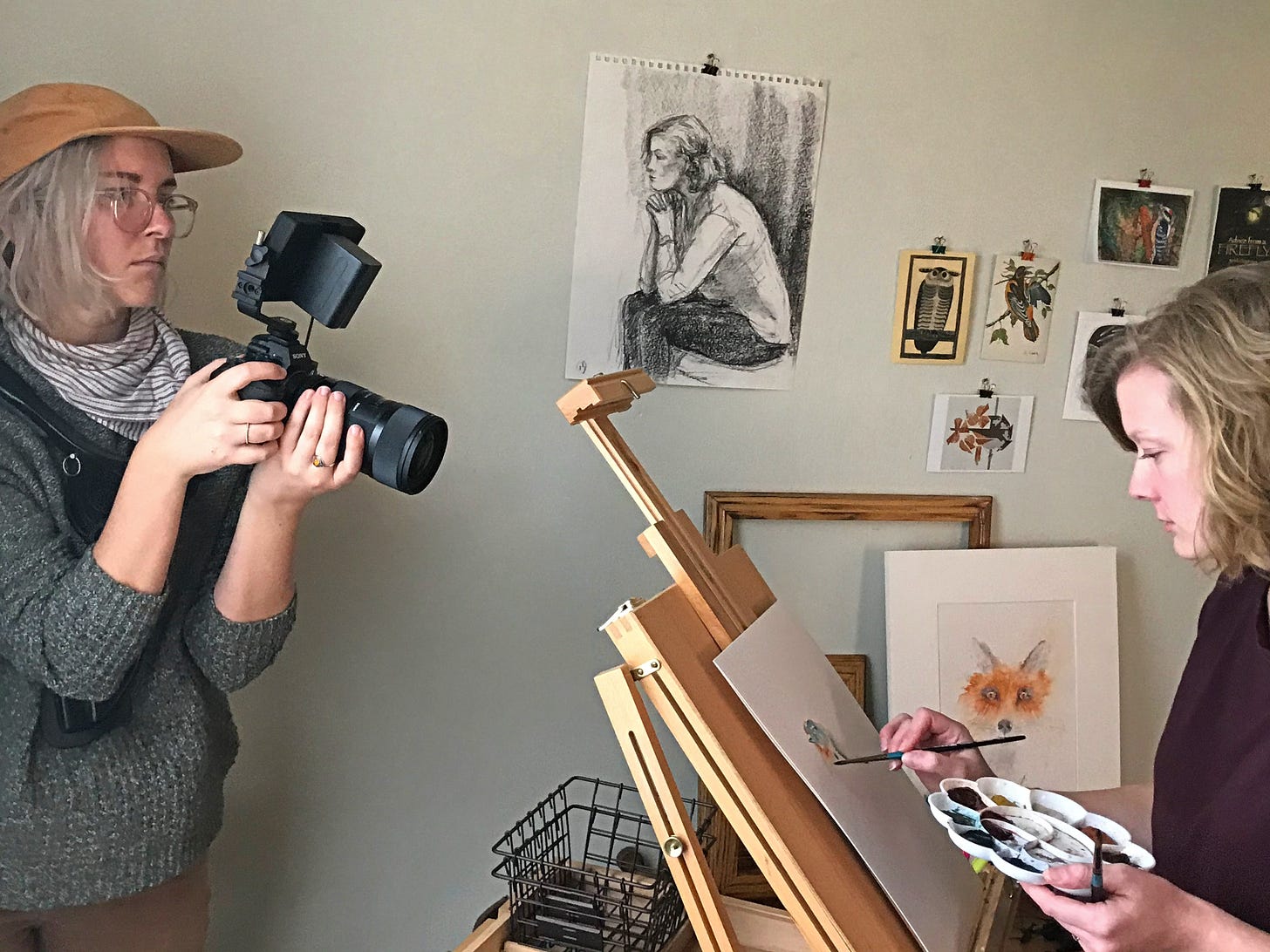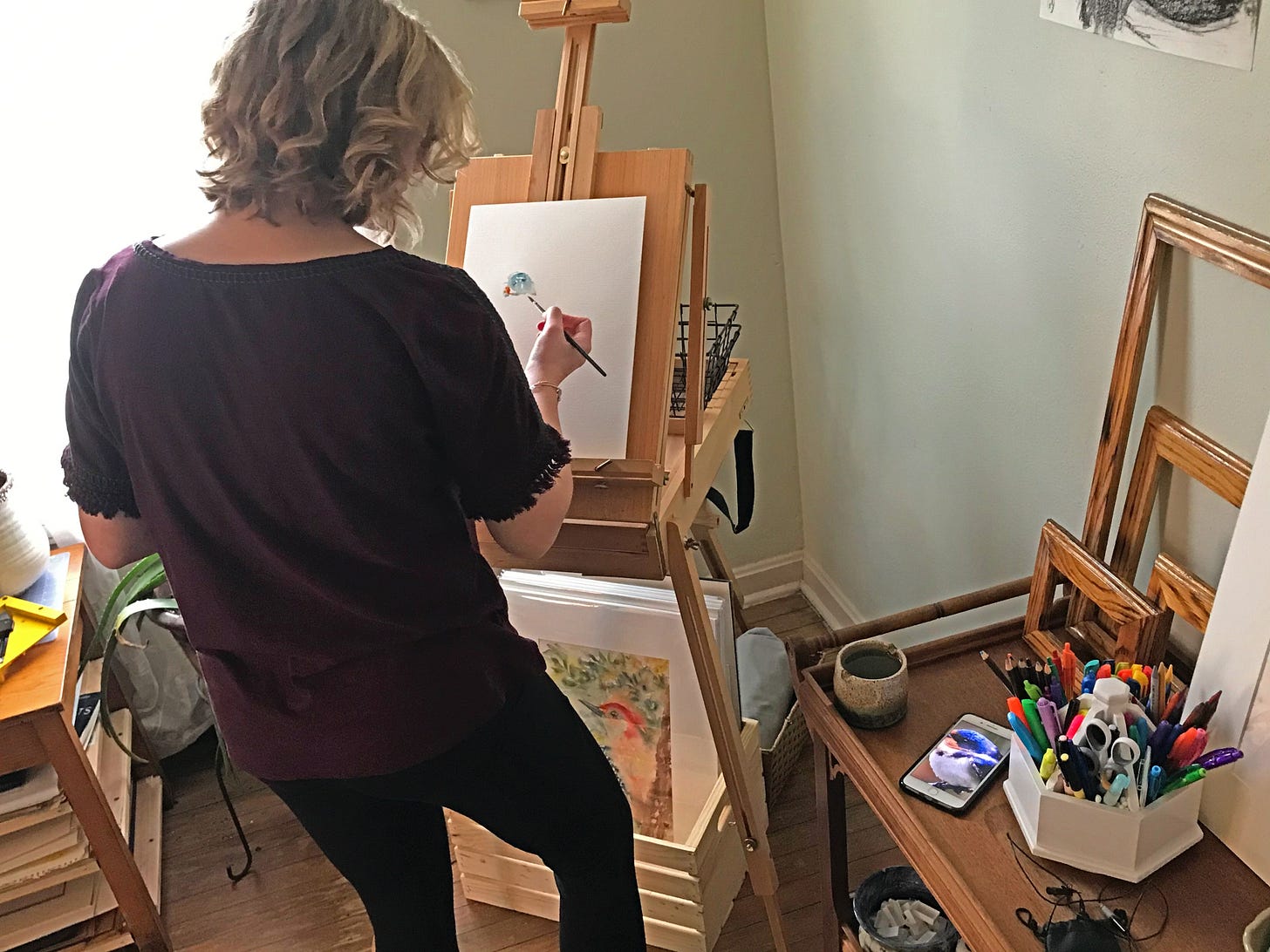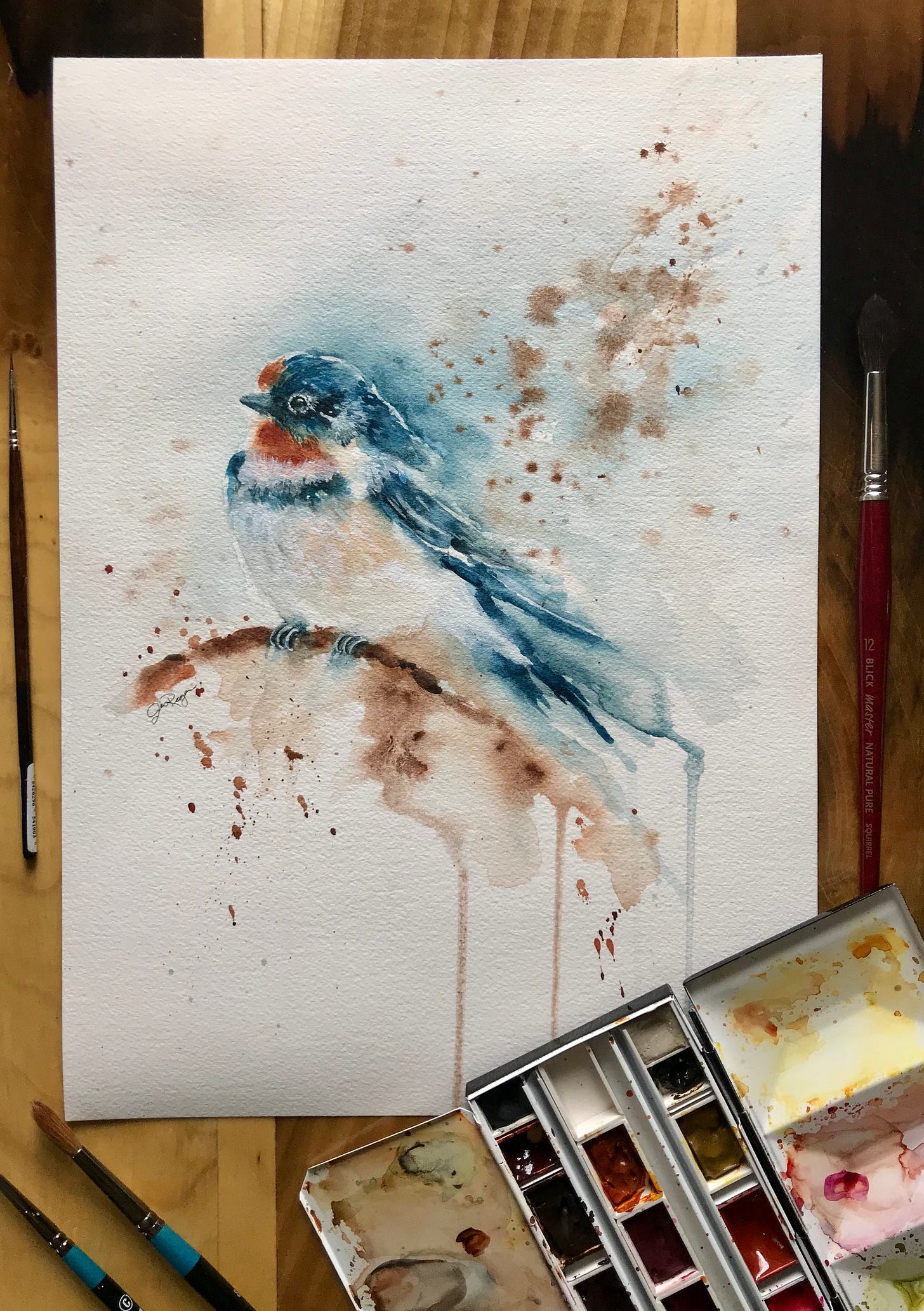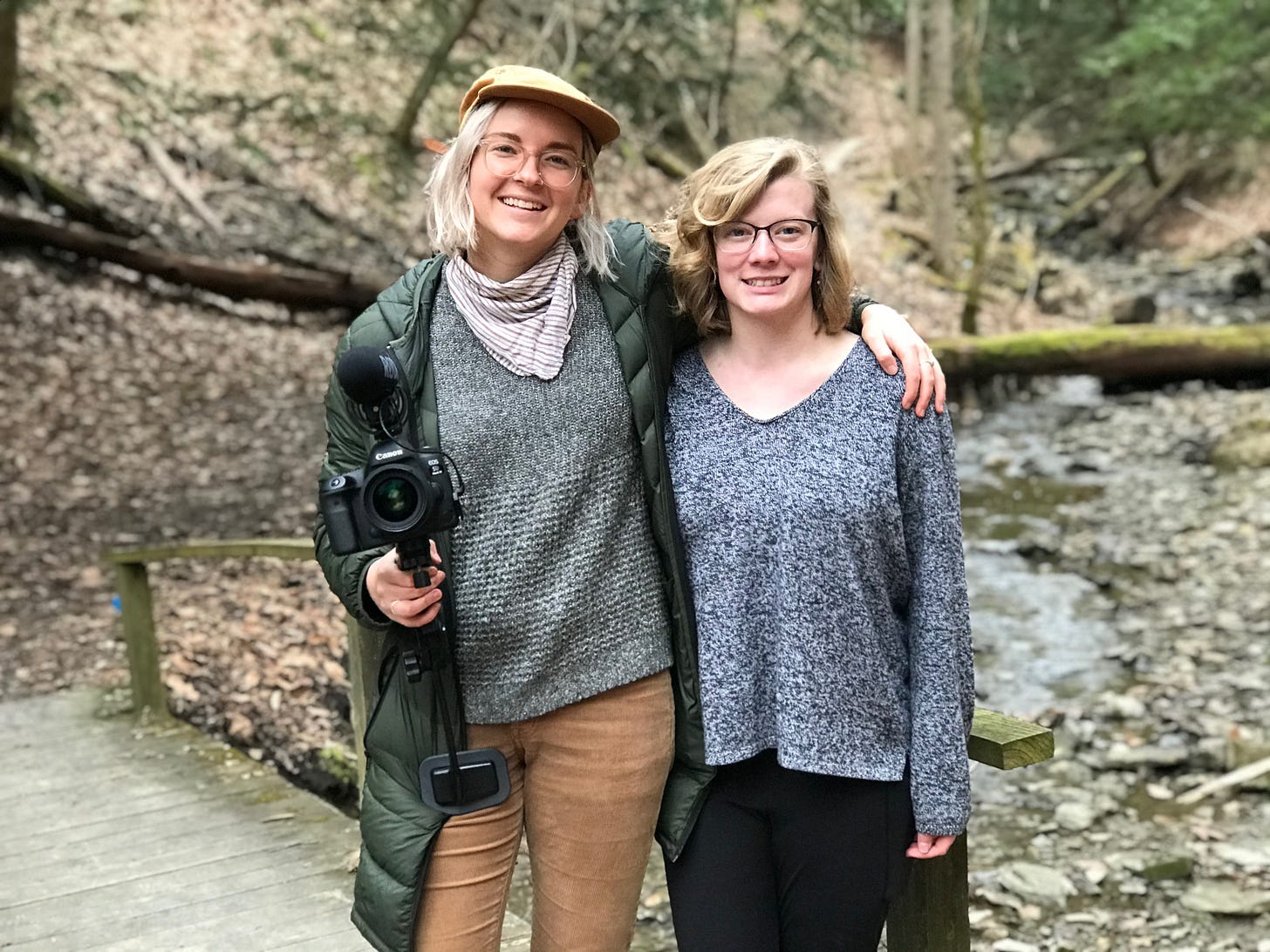Portrait of the Artist in Her Studio & Out
A video portrait of 2020 TFA Emerging Artist Jes Reger | june 30, 2020
Greetings. The pandemic has scrambled everyone’s expectations. Our plans for 2020 at Tamarack Foundation for the Arts were to stay in motion around West Virginia. We set out to profile this year’s 2020 class of Emerging Artist Fellows, while highlighting what emerging, mid-career, and master artists bring to their communities and the world. We also aim to help artists be better business people and to fine-tune how they present their artistry, online and off.
Then came that virus. First, wear a mask in public and practice social distancing! Second, with this newsletter, we’re proceeding with part of our Emerging Artist plans—a series of video, photo, and text profiles of who these five artists are; what they do; and how they do it. We’ve adapted our profile to the pandemic as our questions will show. We begin with Jes Reger and the video profile below, captured by TFA Design Team member Braiden Maddox of Lady Mountain Films in West Virginia.
A Mountain State native, Jes is a watercolorist and teaching artist. She earned her Bachelor of Science in Interdisciplinary Studies, concentrated in Visual Arts and Creative Writing, from West Liberty University in 2014. She teaches art classes to adults and children at Wheeling’s Stifel Fine Arts Center, as well as offering private watercolor and drawing lessons from her home studio, The Painter’s Nest. Enjoy!
NOTE: If this free newsletter was forwarded to you, subscribe at: tamarackforthearts.substack.com. Send questions or comments to renee@tamarackfoundation.org or call 304.926.3770. Be well and stay safe. | Renee Margocee, TFA director


Jes Reger at work in her home studio in Wheeling, during a video shoot by TFA Design Team member Braiden Maddox. | Douglas John Imbrogno photo
1.
How has the pandemic and quarantine affected your work and creative output as an artist?
JES REGER: Initially, quarantine was quite nice. I had wanted to take a week or two off from teaching so I could work on some of my paintings and try new art processes … I did not realize two weeks would turn into more than a dozen!
Early quarantine productivity was fantastic; I accomplished so much in the first three weeks. After that, boredom crept in, and I had to find something else to work on. I am naturally an introverted person, so being alone and not in crowds was perfectly fine by me. But I quickly realized how important human interaction is. I missed my friends, family, and arts community. I felt slightly down and out about the whole social distancing and quarantining arrangement.
Being alone has given me time to reflect on the kind of artist I want to be.
The past couple of weeks have been better, as I have gotten to see more people and get out and about. I have spent most of my pandemic time painting, sketching, and hiking. My nature hikes became my inspiration for a series of botanical drawings depicting florals native to the Mountain State. This little side project has impacted the way I work lately. I find it relaxing to go for a hike with sketchbook in hand—there is something so soothing about nature and how it affects my artwork.
Being alone has given me time to reflect on the kind of artist I want to be. My initial goal was productivity; I was determined to pump out as many paintings as possible. Throughout the pandemic, I learned to slow down and be more observant, not just with my artwork, but also with my daily routine.
TFA Video of 2020 Emerging Artist Fellow Jes Reger of Wheeling WV.
2.
What has been the financial impact of the pandemic on the business aspect of your art production?
I would not say I am struggling financially, however, it has been stressful the last few weeks, not knowing whether I will begin teaching again in my studio. My biggest loss of income was from teaching. I have six students weekly that come to my studio for drawing and watercolor classes, and that is my largest form of income. During our “stay at home” period, I created an online platform to sell prints of my work which has really been a great help financially. As for art production, I have the supplies and funds I need to paint; framing, however, has not been as easily accomplished. My framing supplier in Pittsburgh was shut down for weeks, so I have been unable to order matte board.
It is easy to create art and social distance/stay at home. I can do that by myself. Teaching, however, is difficult to do in a tiny studio space. Hopefully soon I will be able to reopen my studio in a safe manner that protects myself and my students. I will not say it has been easy, and I would very much like to get back to normal (whatever normal will be), because I know sooner or later, bills will pile up. As for now, I am going with the flow; my mom always says “Things will fall into place,” and I am hopeful that will happen.

Jes at work in her Wheeling studio. | Douglas John Imbrogno photo
3.
What are you looking forward to in the year ahead?
I am most looking forward to traveling in the year ahead. My goal for this year was to travel around the Mountain State and meet other artists, to learn from them and possibly create art, as well! There is something so inspiring about visiting another artist’s studio; it helps the creative juices flow.
I never realized what an impact my community has on my artistic career and well-being.
I also just really, really (did I put enough emphasis on “really”?) love West Virginia and have always wanted to spend a year traveling in and around the state. (Another goal of mine was to visit all the state parks, national historic park, state and national forests, etc.—I am currently up to eleven!) Traveling and painting/keeping a sketchbook of my travels has always been at the top of my list.
Also, I am looking forward to working with my artist community again. I never realized what an impact my community has on my artistic career and well-being. I really do miss being surrounded by amazing artists!
4.
Do you think of who your audience is? If so, how might you describe that audience?
Yes, and no. First and foremost, I create for myself. My hope is that others will enjoy my work, as well. I would think my main audience would be nature lovers like myself and individuals who want to learn how to paint in watercolor. Many of my “watercolor peeps” find my watercolor classes at the Oglebay Institute Stifel Fine Arts Center through my artwork. It is really exciting when my audience not only enjoys my artwork, but is also inspired to create, as well. That may just be my favorite part about being an artist—when someone says, “I love your work, and now I want to learn how to paint, too.”

Above is the finished painting Jes is seen working on in the video. | Jes Reger photo
5.
What artist or creative person would you love to come to appreciate or know your artwork today?
Jean Haines. I consider her my mentor and part of the reason I am where I am today. She has been such an inspiration to me, and I would love for her to see how far I have come. And Laura Horn. I love her earthy color palette and abstract style.
6.
What words of encouragement, practical advice, or hard-won insights do you have for a fledgling artist wondering if it’s possible to turn their pleasure for art into a more serious commitment?
Firstly, go for it. What is the worst that can happen? If you love your work and love what you do, you’re golden, Ponyboy.
Never be afraid to ask for help/advice/input from established artists. More than likely, established artists have “been there, done that”. They will always have neat tips and tricks for different art processes that you will never think of yourself. They have spent hundreds of hours creating, messing up, and experimenting. And no matter how constructive their criticism is, they are always encouraging you to keep creating.
Trust me, you will mess up. You will spill something on a painting—if not that, you will end up drinking your paint water instead of your tea.
Take a business class. Probably you will still be confused about how a business works, but that is OK. (I have had my business license for three years and still have no clue what I am doing.)
Make mistakes! Trust me, you will mess up. You will ruin a painting. And you will spill something on a painting—if not that, you will end up drinking your paint water instead of your tea. Sometimes, your best work will come from a mistake. Mistakes give you the freedom to create without inhibitions. (Once you mess something up, you are less likely to worry about messing it up more.)
Keep a sketchbook.
Learn about your chosen medium. How is it made? How was it used in the past? What is unique about your medium?
Do not be discouraged if your business does not take off quickly. All good things take time.
Staying relevant and up-to-date with your work on social media is important, HOWEVER, making connections with your community/artist community is much more valuable.
This video shows the Ogelbay Park woodlands where Jes Reger sketches and seeks out comfort and inspiration. It also shows how Braiden Maddox got those cool overhead shots in the video profile of Jes above.
7.
Ask yourself a question about art, the creative process, the business side of art or what it's like making a go of it as an artist— then answer it.
How do you prevent boredom in the studio?
I love watercolor, and it will always be my first choice. With that said, I do get burnt out every now and then. Keeping a sketchbook is a great way to test out techniques and different styles, and I also like to keep side projects. It is important to take breaks from my main medium, so I try to have multiple projects going at once. Currently, I am finishing up commissions, working on paintings for our TFA show, and compiling my botanical sketches to make into a coloring book.

Braiden Maddox and Jes Reger during the drone video shoot in Oglebay Park, where Jes often goes to sketch and shelter-in-nature. | Douglas John Imbrogno photo

Spread the Word
Next up in our Emerging Artist profiles is Grafton WV artist Jaci Rice, coming July 13. Forward this free newsletter to artists and those in your life who appreciate the arts. If the newsletter was forwarded to you, subscribe at: tamarackforthearts.substack.com to get future issues. (We generally publish 2 issues monthly, plus special themed issues.)
Share comments below, call us at 304.926.3770, or e-mail me directly at renee@tamarackfoundation.org. For media inquires about stories on TFA Fellows or other topics, contact TFA team member Douglas John Imbrogno at douglasjohnmartin@icloud.com or call 304.638.9784.
Be well. Stay Safe. Wear masks. Make art. Appreciate art. Support artists.
Renee Margocee | Executive Director | Tamarack for the Arts



Great article on nature and watercolor painting as an artist.